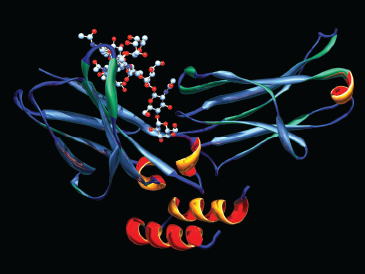
Rituximab drug molecule
Pulmonary arterial hypertension (PAH) in connective tissue disease (CTD) features significant morbidity and mortality. Standard therapies with endothelin receptor antagonists and phosphodiesterase-5 inhibitors have shown some clinical improvement in patients, but these clinical improvements have proved modest when compared with other types of PAH. As our case below suggests, rituximab may show promise as a primary therapy in PAH associated with CTD.
Case Presentation
A 29-year-old Asian female with a history of mixed connective tissue disorder (MCTD) presented to our clinic with dyspnea. She was diagnosed at the age of 2, and her disease manifestations included sclerodactyly, facial tightness and mild myositis. She had an anti-nuclear antibody (ANA) titer of 1:2560 and a ribonucleoprotein (RNP) result greater than 100. She was negative for double-stranded DNA (dsDNA), anti-Smith, anti-Ro/SSA and anti-La/SSB antibodies. She was on a standing immunosuppressive regimen of mycophenolate mofetil 1 g twice a day, hydroxychloroquine 200 mg twice a day and prednisone doses ranging from 1 mg daily up to 40 mg daily depending on disease activity.
Due to her dyspnea in the setting of MCTD, a transthoracic echocardiogram was obtained. It demonstrated severe pulmonary hypertension (PASP 85) with a dilated hypertrophied right ventricle and moderately reduced right ventricular systolic function. Her six-minute walk test (6MWT) demonstrated an ambulation of 1,570 feet on room air with a corresponding modified Borg dyspnea score of 5. A right heart catheterization was obtained and showed a right ventricle systolic pressure of 74 mmHg, a right ventricle diastolic pressure of 10, a pulmonary capillary wedge pressure of 10 and a pulmonary artery mean pressure of 51. A pulmonary angiography was negative for chronic or acute thrombopulmonary embolus. She was classified with PAH class IIIA and eventually started on ambrisentan.
A repeat transthoracic echocardiogram one year later demonstrated an estimated pulmonary arterial systolic pressure of 72 mmHg and moderate to severe reduction in right ventricular systolic function. Her 6MWT and Borg dyspnea scores remained the same. Thereafter, she was lost to follow-up with pulmonology for about a year. She continued to see a rheumatologist during this period, and she was started on rituximab infusions for severe thrombocytopenia and vasculopathic lesions on her toes with no other major changes made to her medication regimen.
She reestablished care with pulmonology three months after starting rituximab infusions and reported significant improvement in her dyspnea. At that time, a transthoracic echo showed a normal right ventricular systolic function and insufficient tricuspid regurgitation to estimate either the right ventricular systolic pressure or her pulmonary artery pressure. Her 6MWT improved to 1,640 feet with a Borg dyspnea score of 3.
Discussion
PAH in CTD is a rare complication occurring in 0.5–14% of patients.1 Several studies have shown that in patients with PAH secondary to systemic lupus erythematosus (SLE), the two-year mortality rate can run up to 50%.1
